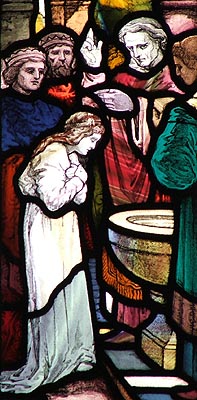 |
 |
|||
|
|
 St.
Aebbe the Elder, St.
Aebbe the Elder,Abbess of Coldingham (c.AD 615-AD 683) Two saints of the name of Aebbe were abbesses of the double Benedictine monastery of Colud, or Coldingham, near Berwick, with an interval of about two hundred years between them. The first was the daughter of King Aethelfrith the Ravager of Bernicia, by his third wife, and sister of St. Oswald and Oswiu, Kings of Northumbria; and, on her mother's side, niece of St. Edwin, King of Northumbria. On the death of Aethelfrith, Edwin, chief of the rival race of Deira, became King and Aebbe, then about ten years old, fled with her seven brothers to Scotland. They were hospitably received by Dumnual Brec, the King, and there they became Christians. Aidan, a Scottish prince, wished to marry Aebbe, and her brothers favoured his suit, but being bent on a religious and celibate life, she took the veil from St. Finan, Bishop of Lindisfarne (circa AD 655). Aidan followed her, intending to take her by force and make her his wife, but Aebbe betook herself to a high rock; round which, at her prayer, high tide ran for three days, forming a perfect defence against her pursuers. Observing her resolute desire, Aebbe's brother, Oswiu, gave her an old Roman camp in County Durham in which to found her first monastery, called Ebchester (Aebbe's castle or camp). She built her greater and more famous monastery on a promontory in Berwickshire, which rises on three of its sides perpendicularly from the sea, and was out off from the land on the fourth side by an almost impassable morass, further strengthened by a high wall. The building was a little way south of the rock now called St. Abb's head. From it can be seen the Scottish coast, to the opposite side of the Forth, and the English coast, as far as Lindisfarne and Bamburgh. A old legend explains the foundation. When Oswiu's kingdom was distracted, by broils and wars, Aebbe became a prisoner, but escaped. Finding a boat on the Humber, she went in it, alone, down the river and out to sea. Some monks were singing in a church on the cliff, afterwards called by her name. They saw the boat, steered through tremendous waves by a superhuman being, come safely to land, a little to the south of the Head. On this spot, she built her church and monastery. Here she ruled one of the double communities of monks and nuns which were usual in Saxon times and always governed by the abbess. She invited St. Cuthbert, Prior of Melrose, and afterwards Abbot of Lindisfarne, to visit her and her nuns. He generally avoided the society of women, but thought so highly of Aebbe that he came to stay with her. As a gift, she gave him the piece of cloth in which eventually he was buried. Egfrith, King of Northumbria, was Aebbe's nephew. When his first wife, St. Etheldreda, left him, she took refuge at Coldingham and the phenomenon which had saved Aebbe from pursuit was repeated in favour of Etheldreda. Egfrith, arriving to bring her back, saw the sea flow into the marsh on the landward side of the rock, making an effectual barrier until he gave up the chase. Etheldreda then became a nun under Aebbe's care for a time. When she had become Abbess of Ely, and Egfrith had married again, he made a tour through his northern dominions with his second wife, Ermenburga, and sought his niece's hospitality for a night on the way. During the night, the Queen suffered a severe flagellation, which some ascribed to angelic, some to diabolic, agency. She was found in convulsions in the morning and Aebbe, with all the authority of aunt and abbess, and perhaps already also of saint, told the King that this visitation was in consequence of his and the Queen's behaviour to St. Wilfrid, Abbot of Hexham and Bishop of York. They had imprisoned him at Dunbar and Ermenburga had robbed him of a reliquary which he valued and which she superstitiously carried with her wherever she went. Although, being ill-gotten, it had only brought her ill luck. They promised to liberate the bishop and restore him his property without delay. Thus the Queen soon recovered. Although Aebbe could act with decision on occasion, she did not succeed in maintaining strict discipline in her monastery and abuses crept in. One of the monks, named Adomnan, was warned, in a vision, that the place would be burnt to ashes as a punishment for the laxity of the inhabitants. Even the cells, which were built for prayer, were converted into places of revelry, drinking, conversation and other amusements. Even the virgins, dedicated to God, spent their leisure in making fine garments to adorn themselves "wherefore a heavy vengeance from Heaven is deservedly prepared for this place and its inmates." When this was told to Aebbe, she was much distressed, but Adomnan gave her the consolation that it should not happen in her life-time. The monks and nuns having heard the vision, began to be alarmed and, for a time, to be more circumspect. However, after the death of Aebbe - at Coldingham on 25th August AD 683 - they fell into greater disorders than ever and then, through carelessness, the monastery caught light and was burnt to the ground. This first monastery probably consisted of small buildings of wood or wattle and mud. It is not exactly known when it was restored. Some have conjectured that it was rebuilt for nuns only, as there is no mention of monks at the time of the martyrdom of St. Aebbe the Younger. The later Priory of Coldingham was built by Edgar, King of Scots, in about 1099; not on the same spot as the monastery, but farther inland. It was dedicated in the name of SS. Cuthbert, Mary and Aebbe. Edited from Agnes Dunbar's "A Dictionary of Saintly Women" (1904).
|
|||
| © Nash Ford Publishing 2001. All Rights Reserved. | ||||


